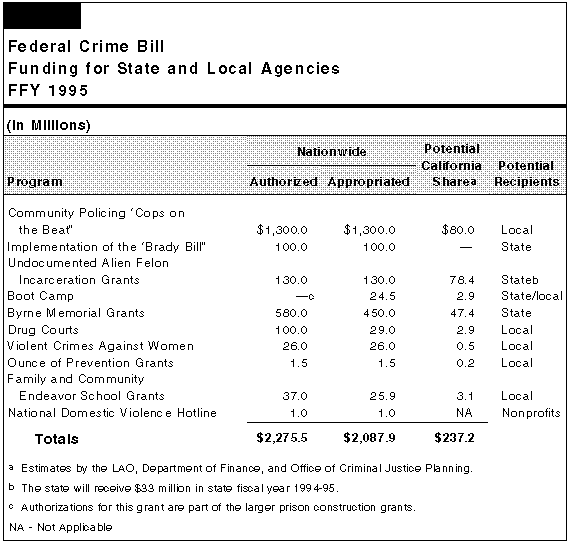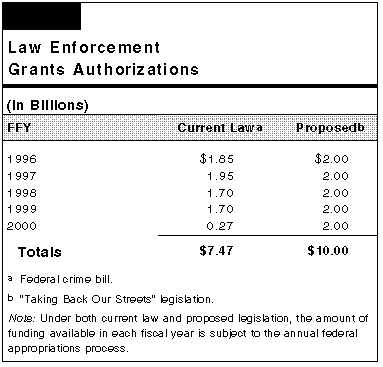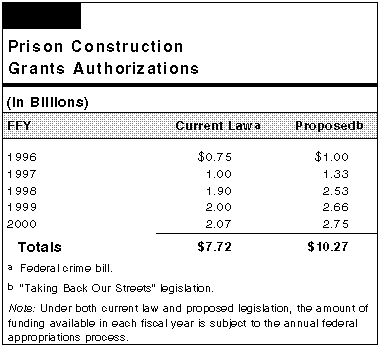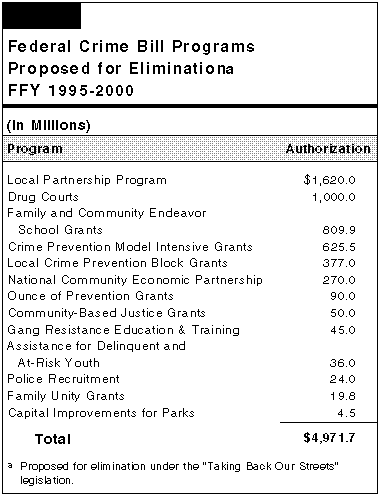California law enforcement agencies have already received some federal funds from the federal crime bill, although overall the funds appropriated for federal fiscal year (FFY) 1995 are less than the amounts authorized in the bill.
The federal crime bill contains a variety of provisions including increasing penalties for federal crimes, adding new federal law enforcement personnel, and most importantly to the state, funding authority for local law enforcement, prison construction, and crime prevention. The bill provides funding authority over a six- year period totaling $30.2 billion, ending in FFY 2000 (state fiscal year 2000-01). The actual funds available for each year will be determined through the annual federal appropriations process.
Funding, when it is appropriated, will be awarded to states and local governments on either a formula basis or as competitive project grants. Many of the crime bill's grant programs are aimed at the local level either law enforcement, local government or community-based organizations. For example, local law enforcement agencies will be the primary recipients of the Cops on the Beat law enforcement grants, authorized for $8.8 billion. Most of the crime bill's prevention grant programs allow for the direct application by local governments and community-based organizations. State government's major share of the federal grant monies will be for the prison construction grant programs, which are not authorized until FFY 1996. Consequently, these funds will not be available until 1996-97, at the earliest.
Appropriations for State and Local Agencies in California. The crime bill authorized funding for 17 programs for FFY 1995, totaling $2.9 billion. Federal appropriations for FFY 1995, however, provided funds for only 11 programs (10 for state and local governments and 1 for federal agencies), totaling $2.3 billion, or about 20 percent less than the amounts authorized for the first year. (Six first-year programs received no funding.) The funding for the new appropriations comes from savings resulting from reductions in federal personnel recommended in the Vice President's National Performance Review.
Figure 4 compares federal authorizations with appropriations for the 10 programs that provide grants to state or local agencies. The figure provides estimates of California's share of these appropriations and the types of agencies which could receive the funds.

In determining California's potential share of federal grant funding, only the amounts for Bryne Memorial Grants (used for local and statewide anti-drug enforcement), Violent Crimes Against Women grants, and incarceration of undocumented felons are relatively exact, because these grants are provided on the basis of a specific formula.
As regards funds for incarcerating undocumented felons, California will receive one-third of the funds, or about $33 million, appropriated in FFY 1995 for state fiscal year 1994-95. The remaining two-thirds of the FFY 1995 appropriation will be available in state fiscal year 1995-96. At the time this Analysis was prepared, the state had not received its $33 million from the federal government. According to the administration, this is because the federal government wants the state to relinquish its claim for full reimbursement before it will provide the amounts appropriated.
For the other programs, the estimates are based on the total appropriation divided by California's share of the target grant population. Accordingly, the actual amounts received by the state may vary from the estimates shown in Figure 4 (see next page).
Appropriations for Federal Agencies in California. The appropriations for federal law enforcement agencies and for a program to accelerate deportation hearings have been allocated. The federal government reports that it will add 2,365 Immigration and Naturalization Service (INS) employees, of which 598, or 25 percent, will be in California. These personnel will be used for both expediting deportation hearings and for investigating industries that hire undocumented immigrants. This total also includes 200 additional Border Patrol agents for the San Diego region. The federal government also reports that it will add a new fingerprinting technology to improve identification of undocumented immigrants. Currently, the INS relies on names to identify such persons.
The largest appropriation for FFY 1995 is for state and local law enforcement agencies through the Cops on the Beat program. The intent of the program is to provide funds to hire police officers and increase their involvement in the community. The crime bill authorizes the U.S. Attorney General to make grants through this program to state and local governments, and other public and private entities, such as transit districts, school districts, and college police departments.
Grant Restrictions. While law enforcement agencies can use some of the funds for equipment and training, the bulk of the grant has to be used for hiring police officers. In addition, the grants are limited to three years, the recipient agency must cover 25 percent of the costs, and the grant is limited to paying no more than $25,000 per year towards officer salaries and benefits. Because the grants are limited to three years, recipient agencies will have to shoulder the full costs of the newly hired officers after the grant period, or layoff the new officers. There are no federal funds available to offset other criminal justice system costs, such as the costs for courts, jails, and probation, that will result from adding law enforcement personnel.
California's Share. As Figure 4 shows, we estimate that California could receive about $80 million under this program, based on allocations already made to law enforcement agencies and those that are still eligible. In fact, as of January 1995, 40 California law enforcement agencies have received Cops on the Beat grants totaling $28.6 million. These grants are expected to add 303 law enforcement officers. Grants to individual law enforcement agencies varied from $3 million to the Los Angeles County Sheriff for 33 new officers to three small city police departments (Corning, King City, and Lemoore) of $75,000 for 1 officer each. Nationwide, $200 million in grants have been awarded so far.
While California has already received $28.6 million from this grant program, it is possible that the state will not receive significantly larger shares of future funding allocations. This is because some California law enforcement agencies have decided not to apply for the federal grants unless they had already planned to add new officers because of the potential significant costs to local government. For example, the Oakland police department decided that the limit on federal funds of $25,000 per officer for salaries and benefits is not sufficient to justify hiring officers whose average salaries and benefits total almost $75,000 a year. Other law enforcement agencies have decided not to apply for grants because they believe there will not be local funding available after the grant expires to support the full costs of new officers.
Legislation has been introduced in Congress to amend the federal crime bill with provisions contained in the Contract With America. This proposed legislation is entitled the Taking Back Our Streets Act. The proposed legislation would significantly change many of the provisions of the crime bill enacted in September 1994. The major proposed changes are discussed below.
The proposed legislation would modify the law enforcement grant program by increasing the funding authorizations and eliminating certain grant eligibility requirements. Specifically, the proposed legislation increases funding authorizations for law enforcement from $7.5 billion to $10 billion, for the period FFY 1996 through FFY 2000. Figure 5 compares the funding authorizations of current law and the proposed legislation.

In addition, the proposed legislation eliminates many of the grant limitations contained in the existing crime bill, making the measure essentially a block grant. Specifically, the proposal:
We believe that these proposed amendments would lead to a much greater share of grant funds for California law enforcement agencies than under the existing Cops on the Beat program because all California law enforcement agencies would receive federal funding. California's share of the proposed program could be $1.4 billion through FFY 2000 an increase of at least several hundred million dollars over the amounts authorized in the current law.
The proposed legislation amends the prison construction grant requirements and funding authorizations. Specifically, the proposed legislation would increase the amounts authorized for prison construction from the federal crime bill's authorizations of $7.7 billion to $10.3 billion, as shown in Figure 6. In addition, part of the funding would be available for local jail construction, unlike the existing crime bill. Consequently, this proposed change would benefit California because of the current need to relieve overcrowding in local jail facilities. Currently, 28 county jail systems accounting for over 70 percent of all of the state's jail beds are under court-ordered population caps. California's share under the proposed legislation could be $1.5 billion an increase of a few hundred million dollars over the current law amounts.

The proposed legislation will eliminate 13 of the crime prevention programs contained in current law saving $5.0 billion in funding authorizations. The elimination of these programs pays for the proposed increases in funding authorizations ($5.1 billion) for law enforcement and prison construction grants. Elimination of these programs could result in California receiving several hundred million dollars less for crime prevention programs than it might overwise receive under current law. Figure 7 shows which programs the proposed legislation would eliminate.

In addition to changes to the grant programs, the proposed legislation seeks to modify federal law to expedite death penalty appeals at the federal level. Faster appeals might reduce defense and other appellate costs for the State Public Defender, who defends persons who receive the death penalty, and the DOJ which represents the state in appellate court.
The proposed legislation also would amend federal law to greatly restrict the ability of inmates to file lawsuits. Such changes could also result in savings to the state to defend itself against inmate lawsuits. For 1995-96, the budget proposes $12.6 million for such defense work in the CDC and the DOJ.
The proposed amendments to the federal crime bill will mostly benefit the state and local law enforcement agencies through increased funding for police, jails, and prisons. However, local governments and community-based organizations, and nonlaw enforcement local government agencies lose, if the proposed elimination of crime prevention grants is adopted.
As we noted in our September policy brief, we believe the Legislature and the administration should develop an overall state strategy for implementing the current crime bill in California. Subsequently, the Governor has issued an executive order designating the Office of Criminal Justice Planning (OCJP) as the state agency responsible for coordinating the state's implementation of the federal crime bill. The OCJP's responsibilities under the executive order include: ensuring that the state receives its fair share of federal funding; providing technical assistance to state and local agencies; and working with state agencies to designate the appropriate agencies within California to implement the federal crime bill.
Regardless of the Governor's charge to the OCJP, we believe that our recommendations are still applicable. The same recommendations would also pertain if proposed amendments to the federal crime bill are enacted by the Congress. In particular, we recommend that the legislation specify the following: